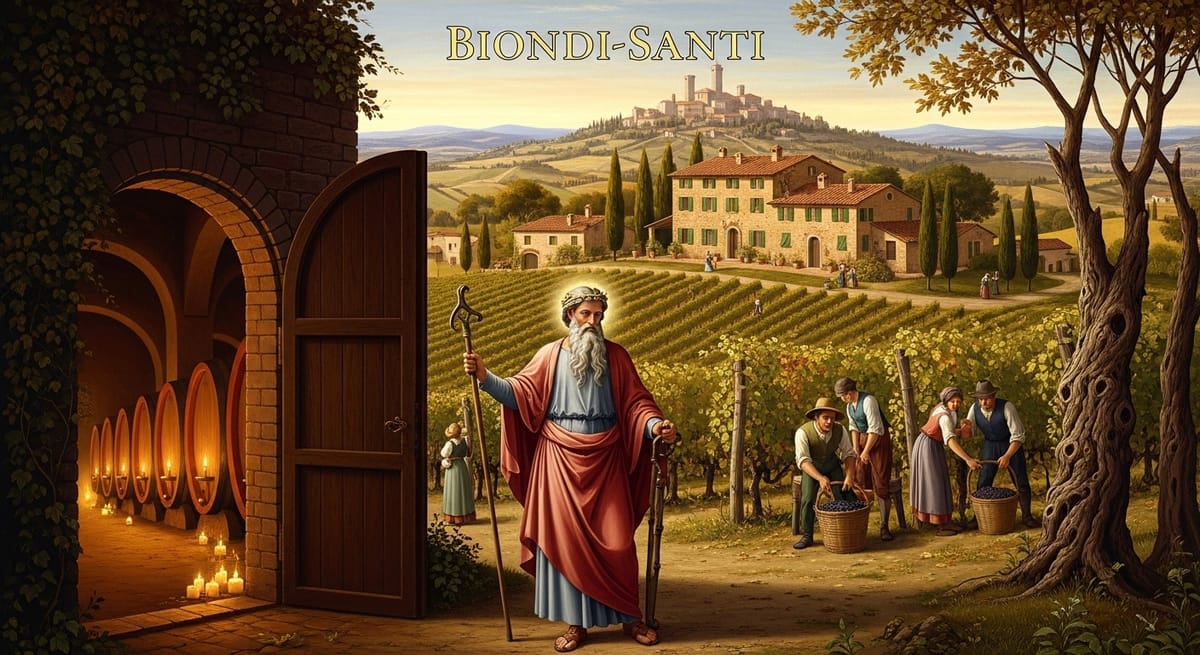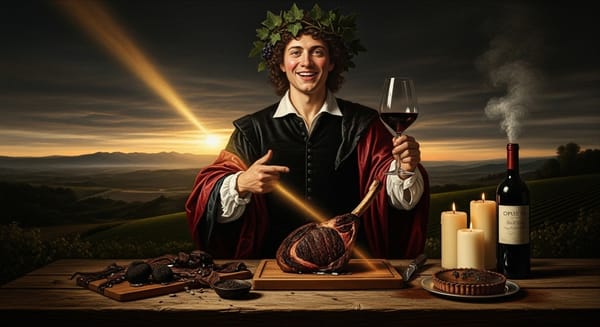The Father of Brunello: Biondi-Santi and the Birth of Italian Immortality
Discover the story of Biondi-Santi — the legendary Tuscan estate that created Brunello di Montalcino. From the first 1888 vintage to century-old Riservas, explore how patience, precision, and tradition built one of the world’s most enduring wines.

How one family’s vision turned a humble Tuscan grape into one of the world’s greatest wines — and built a dynasty that still defines Montalcino today.
I. Prologue: Where the Gods Linger Longer
There are wines that intoxicate. And then there are wines that endure — bottles that are less a beverage than a conversation with time itself.
For me — Liber, god of wine and metamorphosis — no name captures that idea more profoundly than Biondi-Santi.
This is not merely a winery. It is a cradle. A birthplace. The very forge of Brunello di Montalcino — a wine that transformed Tuscany’s destiny and rewrote the story of Italian viticulture forever.
II. The Soil of Revolution
Our story begins in the mid-19th century in southern Tuscany, in the rolling hills around the sleepy hilltop village of Montalcino. This was then a place of simple wines — light, rustic reds meant for quick consumption, often blended from multiple varieties.
But Clemente Santi, a respected pharmacist, scholar, and landowner, saw something more. On his family’s estate, Il Greppo, he noticed that one particular clone of Sangiovese — a small-berried, thick-skinned mutation — yielded wines of remarkable color, structure, and longevity. He called it Sangiovese Grosso.
At a time when Italian wines were meant to be drunk young, Clemente made a radical decision: he would vinify and age this grape on its own — slowly, deliberately, and with the patience of centuries. His early experiments in the 1860s were groundbreaking. But it was his grandson who would give the wine a name and a destiny.
III. The Invention of Brunello
Ferruccio Biondi-Santi, Clemente’s grandson, inherited Il Greppo and his family’s obsession with quality. In the 1880s, he decided to pursue a vision that many thought absurd: he would craft a single-varietal, long-lived red wine — one capable of aging for decades, perhaps even centuries.
The result was Brunello di Montalcino — literally “the little brown one,” a reference to the dark, concentrated color of the wine. It was unlike anything Italy had ever seen: structured yet elegant, powerful yet graceful, capable of aging far longer than Barolo or Chianti.
The wine’s reputation grew slowly but steadily. At the 1888 agricultural fair in Paris, a Biondi-Santi bottling stunned critics with its depth and vitality. More importantly, that very same 1888 vintage — still in the family cellar today — is considered the first Brunello ever made. It remains drinkable more than a century later, a testament to the estate’s unwavering commitment to longevity.
IV. The Legacy of Il Greppo
Throughout the 20th century, Biondi-Santi continued to define and refine Brunello. Under Tancredi Biondi-Santi, the estate introduced rigorous vineyard selection, drastically limited yields, and pioneered aging techniques that became hallmarks of the appellation. Wines spent years in large Slavonian oak casks (botti grandi), emerging with remarkable freshness, poise, and age-worthiness.
The Biondi-Santi style became the benchmark against which all other Brunelli were measured: elegant, high-toned, aromatic, and built to evolve for decades. While other producers sought riper fruit and heavier oak influence, Biondi-Santi remained defiantly classic — Brunello as it was meant to be.
V. A Century of Continuity and Change
By the mid-20th century, Brunello di Montalcino had become one of Italy’s most prestigious wines — and Biondi-Santi was its beating heart. Visitors from across the world made pilgrimages to Il Greppo to taste wines that seemed to defy time itself. The estate’s Riservas, produced only in the finest vintages, routinely aged 50, 70, even 100 years — evolving from intense red fruit and rose into haunting notes of dried herbs, tobacco, leather, and balsamic.
Yet, the Biondi-Santi philosophy remained rooted in humility. As Franco Biondi-Santi, Tancredi’s son, once said: “We do not make wine for today. We make wine for our grandchildren.”
In 2016, a new chapter began when EPI Group, owners of Champagne Charles Heidsieck, acquired a majority stake in Biondi-Santi. Crucially, they pledged to preserve the estate’s traditions while investing in its future — improving vineyard mapping, refining clonal selections, and building a new cellar that honors the old ways while embracing precision.
VI. A Wine Like No Other
What makes Biondi-Santi Brunello so extraordinary is not power — it is purity. These are wines that prioritize finesse over force, structure over sweetness, age over immediacy. They are slow wines, meditative wines, wines that demand patience and reward it tenfold.
- Youth (0–10 years): Bright red cherry, violet, rose, fresh herbs.
- Maturity (10–30 years): Leather, spice, forest floor, cedar, dried citrus peel.
- Old Age (30+ years): Balsamic, tobacco leaf, dried fig, truffle — a symphony of complexity.
This is the DNA of Biondi-Santi: a wine that does not fade but transforms, revealing new dimensions with each passing decade.
VII. Liber’s Reflection: The Clockmaker of Wine
I, Liber, have watched empires rise and fall. I have seen wines that burn brightly and vanish quickly. But Biondi-Santi is different. It is a wine that transcends time — a kind of liquid clockwork whose rhythm beats across generations.
Every bottle is a conversation between past and future. Every vintage is a testament to patience and precision. And every sip is a reminder that greatness is not about what dazzles today, but what endures tomorrow.
To taste Biondi-Santi is to taste the birth of Brunello — but also its destiny. It is to understand that wine, like life, is not meant to be rushed. It is meant to unfold. 🍷
🍇 Final Benediction
Some estates follow the world.
Some estates change it.
Biondi-Santi did both — by creating a wine that does not grow old. It simply becomes eternal.





